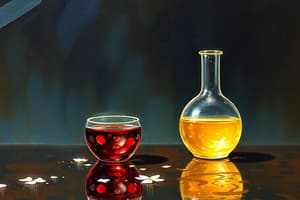Podcast
Questions and Answers
Consider a reversible reaction at equilibrium. Which statement accurately describes the rates of the forward and reverse reactions?
Consider a reversible reaction at equilibrium. Which statement accurately describes the rates of the forward and reverse reactions?
- The reverse reaction rate is significantly higher than the forward reaction rate.
- The forward reaction rate is significantly higher than the reverse reaction rate.
- The forward and reverse reaction rates are equal. (correct)
- Both forward and reverse reactions have ceased.
How does a reaction at equilibrium differ from a reaction that has reached completion?
How does a reaction at equilibrium differ from a reaction that has reached completion?
- At equilibrium, all reactants have been converted to products, whereas a completed reaction still contains some reactants.
- There is no difference; the terms are interchangeable.
- At equilibrium, the rates of the forward and reverse reactions are equal, whereas a completed reaction proceeds only in the forward direction until all reactants are used up. (correct)
- At equilibrium, the reaction has stopped, whereas a completed reaction is still ongoing.
Which statement accurately describes a system at dynamic equilibrium?
Which statement accurately describes a system at dynamic equilibrium?
- The concentrations of reactants and products are equal.
- The rates of the forward and reverse reactions are zero.
- The forward reaction has stopped, but the reverse reaction continues.
- The rates of the forward and reverse reactions are constant and equal. (correct)
The equilibrium constant, K, for a reaction is 50. What can be inferred from this value?
The equilibrium constant, K, for a reaction is 50. What can be inferred from this value?
What is the correct relationship among the equilibrium constants $K$, $K_c$, and $K_p$ for a given reaction?
What is the correct relationship among the equilibrium constants $K$, $K_c$, and $K_p$ for a given reaction?
Given the balanced chemical equation $aA + bB
ightleftharpoons cC + dD$, which expression correctly represents the equilibrium constant K?
Given the balanced chemical equation $aA + bB ightleftharpoons cC + dD$, which expression correctly represents the equilibrium constant K?
For which states of matter are concentrations typically excluded from the equilibrium constant expression and why?
For which states of matter are concentrations typically excluded from the equilibrium constant expression and why?
How does the magnitude of the equilibrium constant, $K$, relate to the relative amounts of products and reactants at equilibrium?
How does the magnitude of the equilibrium constant, $K$, relate to the relative amounts of products and reactants at equilibrium?
Given the reaction $N_2(g) + 3H_2(g)
ightleftharpoons 2NH_3(g)$ with equilibrium constant $K_1$, what is the equilibrium constant, $K_2$, for the reaction $2N_2(g) + 6H_2(g)
ightleftharpoons 4NH_3(g)$?
Given the reaction $N_2(g) + 3H_2(g) ightleftharpoons 2NH_3(g)$ with equilibrium constant $K_1$, what is the equilibrium constant, $K_2$, for the reaction $2N_2(g) + 6H_2(g) ightleftharpoons 4NH_3(g)$?
If reaction 1 has an equilibrium constant of $K_1$ and reaction 2 has an equilibrium constant of $K_2$, what is the overall equilibrium constant $K_3$ if the two reactions are added together?
If reaction 1 has an equilibrium constant of $K_1$ and reaction 2 has an equilibrium constant of $K_2$, what is the overall equilibrium constant $K_3$ if the two reactions are added together?
In an ICE table, what does the 'C' row represent, and how is it determined?
In an ICE table, what does the 'C' row represent, and how is it determined?
How do you decide which direction the reaction will proceed in when constructing an ICE table?
How do you decide which direction the reaction will proceed in when constructing an ICE table?
When using an ICE table to determine equilibrium concentrations, what is the significance of the variable 'x'?
When using an ICE table to determine equilibrium concentrations, what is the significance of the variable 'x'?
Which of the following can be determined using an ICE table?
Which of the following can be determined using an ICE table?
What information is required to fully complete an ICE table with numerical values (no variables)?
What information is required to fully complete an ICE table with numerical values (no variables)?
What is the reaction quotient, Q, and how does it differ from the equilibrium constant, K?
What is the reaction quotient, Q, and how does it differ from the equilibrium constant, K?
If $Q > K$ for a reversible reaction, which of the following statements is correct?
If $Q > K$ for a reversible reaction, which of the following statements is correct?
If $Q < K$ for a reversible reaction, how will the system adjust to reach equilibrium?
If $Q < K$ for a reversible reaction, how will the system adjust to reach equilibrium?
According to Le Châtelier's Principle, what happens to a system at equilibrium when conditions change?
According to Le Châtelier's Principle, what happens to a system at equilibrium when conditions change?
For the exothermic reaction $A(g)
ightleftharpoons B(g) + heat$, how will increasing the temperature affect the equilibrium position?
For the exothermic reaction $A(g) ightleftharpoons B(g) + heat$, how will increasing the temperature affect the equilibrium position?
How does adding an inert gas (one that does not participate in the reaction) at constant volume affect a system at equilibrium?
How does adding an inert gas (one that does not participate in the reaction) at constant volume affect a system at equilibrium?
How does a catalyst affect the equilibrium of a reversible reaction?
How does a catalyst affect the equilibrium of a reversible reaction?
Consider the reaction $2SO_2(g) + O_2(g)
ightleftharpoons 2SO_3(g)$. If the volume of the container is decreased, how will the equilibrium be affected?
Consider the reaction $2SO_2(g) + O_2(g) ightleftharpoons 2SO_3(g)$. If the volume of the container is decreased, how will the equilibrium be affected?
For an endothermic reaction, how does decreasing the temperature affect the equilibrium position?
For an endothermic reaction, how does decreasing the temperature affect the equilibrium position?
What is incorrect about the statement: 'Once a reaction reaches equilibrium, the reaction stops'?
What is incorrect about the statement: 'Once a reaction reaches equilibrium, the reaction stops'?
Why doesn't a catalyst change the position of equilibrium?
Why doesn't a catalyst change the position of equilibrium?
Consider a reaction that is at equilibrium. Which of the following statements is true regarding the concentrations of reactants and products?
Consider a reaction that is at equilibrium. Which of the following statements is true regarding the concentrations of reactants and products?
You are given the initial concentrations of reactants and products, along with the equilibrium constant, K. What is the primary purpose of using an ICE table in this scenario?
You are given the initial concentrations of reactants and products, along with the equilibrium constant, K. What is the primary purpose of using an ICE table in this scenario?
When is the reaction quotient (Q) equal to the equilibrium constant (K)?
When is the reaction quotient (Q) equal to the equilibrium constant (K)?
Flashcards
Chemical Equilibrium
Chemical Equilibrium
Forward and reverse reactions occur at the same rate, maintaining constant reactant and product amounts.
Equilibrium vs. Completion
Equilibrium vs. Completion
Equilibrium is dynamic with ongoing reactions; completion means all reactants convert to products.
Characteristics of Equilibrium
Characteristics of Equilibrium
Rates of forward and reverse reactions are equal; reactions continue; reactant and product amounts are constant.
Equilibrium Constant (K)
Equilibrium Constant (K)
Signup and view all the flashcards
K, Kc, and Kp
K, Kc, and Kp
Signup and view all the flashcards
Writing K Expression
Writing K Expression
Signup and view all the flashcards
States Excluded from K
States Excluded from K
Signup and view all the flashcards
K Value and Reaction Direction
K Value and Reaction Direction
Signup and view all the flashcards
Manipulating Keq
Manipulating Keq
Signup and view all the flashcards
Adding Reactions and K
Adding Reactions and K
Signup and view all the flashcards
ICE Table Problem Types
ICE Table Problem Types
Signup and view all the flashcards
Reaction Quotient (Q)
Reaction Quotient (Q)
Signup and view all the flashcards
Q and Reaction Shift
Q and Reaction Shift
Signup and view all the flashcards
Steps to Calculate Equilibrium Concentrations
Steps to Calculate Equilibrium Concentrations
Signup and view all the flashcards
Le Châtelier's Principle
Le Châtelier's Principle
Signup and view all the flashcards
Concentration Changes and Equilibrium
Concentration Changes and Equilibrium
Signup and view all the flashcards
Volume Changes and Equilibrium
Volume Changes and Equilibrium
Signup and view all the flashcards
Temperature Changes & Equilibrium
Temperature Changes & Equilibrium
Signup and view all the flashcards
Equilibrium Misconception
Equilibrium Misconception
Signup and view all the flashcards
Catalyst and Equilibrium
Catalyst and Equilibrium
Signup and view all the flashcards
Study Notes
The Equilibrium Constant
- Chemical equilibrium occurs when forward and reverse reactions proceed at the same rate.
- At equilibrium, reactants turn into products as quickly as products revert to reactants.
- Amounts of reactants and products remain constant at equilibrium, though the reaction continues.
- Equilibrium differs from completion; reactions at equilibrium are ongoing but balanced.
- Reactions that reach completion have converted all reactants to products and then stop.
- At equilibrium, forward and reverse reaction rates are equal.
- Dynamic equilibrium means forward and reverse reactions continue.
- At equilibrium, the amounts of reactants and products stay constant.
- The equilibrium constant (K) is the ratio of product to reactant concentrations at equilibrium.
- K indicates how far a reaction proceeds toward product formation.
- A large K means the reaction creates many products.
- A small K indicates the reaction produces few products, and more reactants are present.
- K is the general equilibrium constant
- K
cuses concentration units - K
puses pressure units. - To express K, product concentrations are raised to the power of their coefficients, multiplied, and divided by the same process applied to reactant concentrations.
- Products are in the numerator, and reactants in the denominator.
- Solids and pure liquids aren't included in the K expression.
- Their concentrations remain constant and don't affect equilibrium.
- K
cis greater than 1 when there are more products than reactants. - K
cis less than 1 when there are more reactants than products. - K is close to 1 when product and reactant amounts are roughly equal.
- When a reaction is multiplied by a coefficient, raise K
1to the power of that coefficient to find K2 - If a reaction is reversed, take the reciprocal of K
2to find K3 - K
3is K1multiplied by K2if reactions are added
Using ICE Tables and Q
- ICE tables solve equilibrium problems.
- Type 1 problems provide initial concentrations and K.
- Use the ICE table and K to solve for 'x' to find equilibrium concentrations.
- Variable 'x' represents changes in concentration within the ICE table.
- Type 2 problems provide initial and equilibrium concentrations.
- Completely fill out the ICE table to calculate K.
- Both types use ICE tables to organize concentration changes and require writing an equilibrium constant expression.
- Type 1 problems don't provide enough information to complete the ICE table without 'x.'
- Type 2 problems can be fully completed with given values.
- The reaction quotient, Q, uses current concentrations instead of equilibrium concentrations.
- Q predicts the direction a reaction will shift to reach equilibrium.
- If Q < K
c, the system makes more products (proceeds forward). - If Q > K
c, the system makes more reactants (proceeds in reverse). - To calculate equilibrium concentrations:
- Use molarities to write all initial concentrations in an ICE table.
- Use 'x' to represent concentration changes in the 'C' row. Reaction direction matters; a zero initial concentration means the reaction must proceed in that direction.
- The balanced equation is used to write the K expression with equilibrium concentrations. Substitute values from the ICE table into the K expression and solve for 'x.'
- Use 'x' to calculate equilibrium concentrations for all species.
Le Chatelier
- Le Châtelier's Principle: a system at equilibrium responds to counteract changes in concentration, temperature, or pressure, restoring a new equilibrium.
- Add a reactant, the reaction shifts right.
- Remove a reactant, the reaction shifts left.
- Add a product, the reaction shifts left.
- Remove a product, the reaction shifts right.
- Decrease volume, shifts to the side with fewer moles of gas.
- Increase volume, shifts to the side with more moles of gas.
- Increase temperature for an endothermic reaction, shifts right.
- Decrease temperature for an endothermic reaction, shifts left.
- Increase temperature for an exothermic reaction, shifts left.
- Decrease temperature for an exothermic reaction, shifts right.
- Adding a catalyst causes no change.
- At equilibrium, reactants and products interconvert at the same rate, maintaining constant concentrations.
- Catalysts speed up forward and reverse reactions equally.
- Catalysts help reactions reach equilibrium faster without changing equilibrium positions.
Studying That Suits You
Use AI to generate personalized quizzes and flashcards to suit your learning preferences.




